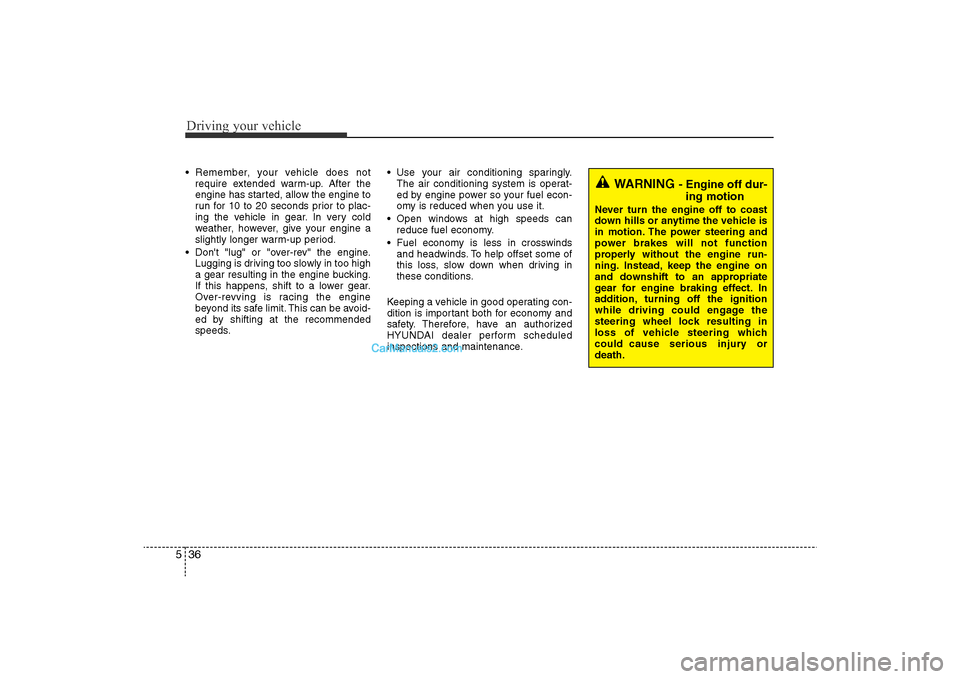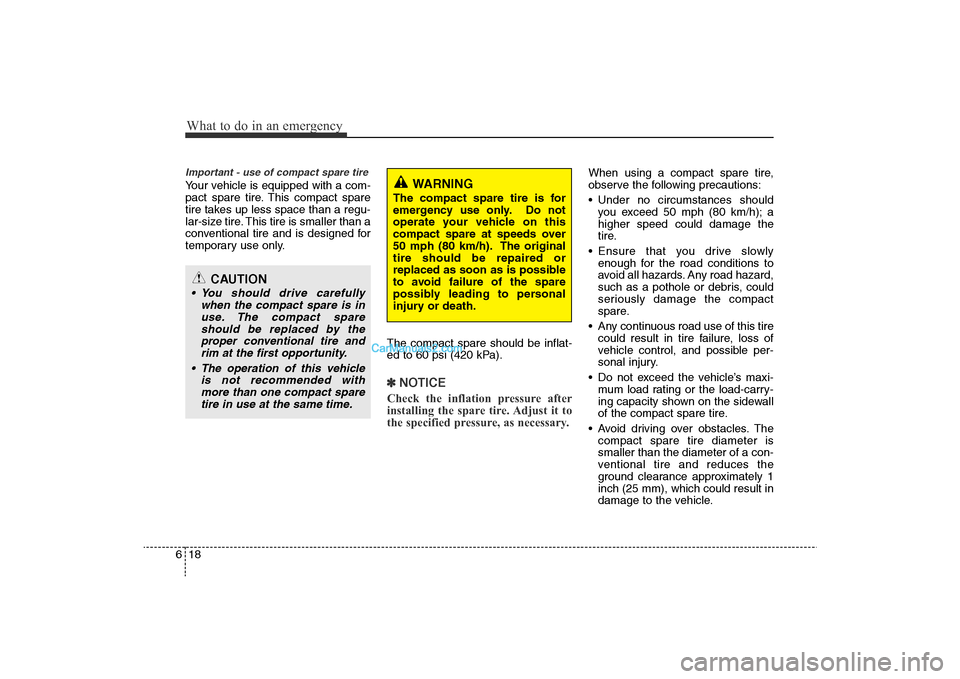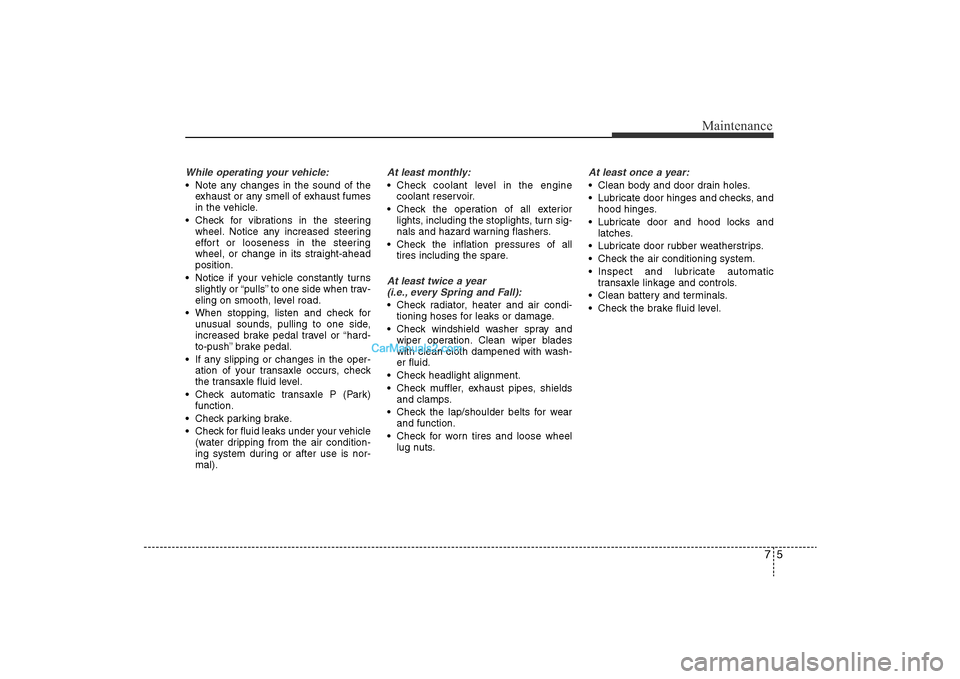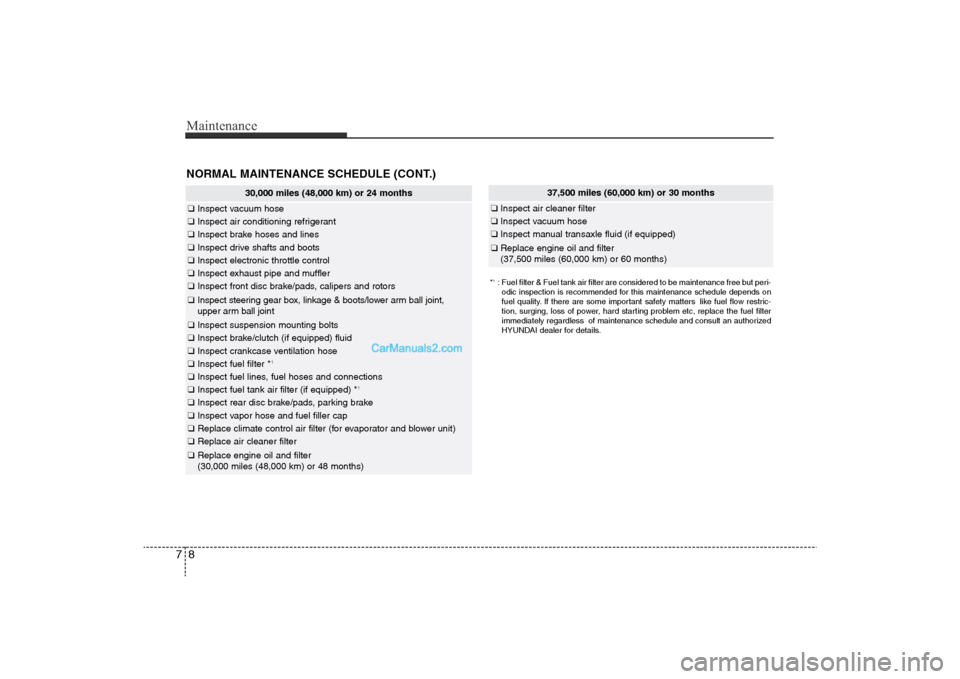2011 Hyundai Sonata air condition
[x] Cancel search: air conditionPage 252 of 380

Driving your vehicle36
5• Remember, your vehicle does not
require extended warm-up. After the
engine has started, allow the engine to
run for 10 to 20 seconds prior to plac-
ing the vehicle in gear. In very cold
weather, however, give your engine a
slightly longer warm-up period.
• Don't "lug" or "over-rev" the engine. Lugging is driving too slowly in too high
a gear resulting in the engine bucking.
If this happens, shift to a lower gear.
Over-revving is racing the engine
beyond its safe limit. This can be avoid-
ed by shifting at the recommended
speeds. • Use your air conditioning sparingly.
The air conditioning system is operat-
ed by engine power so your fuel econ-
omy is reduced when you use it.
• Open windows at high speeds can reduce fuel economy.
• Fuel economy is less in crosswinds and headwinds. To help offset some of
this loss, slow down when driving in
these conditions.
Keeping a vehicle in good operating con-
dition is important both for economy and
safety. Therefore, have an authorized
HYUNDAI dealer perform scheduled
inspections and maintenance.
WARNING
- Engine off dur- ing motion
Never turn the engine off to coast
down hills or anytime the vehicle is
in motion. The power steering and
power brakes will not function
properly without the engine run-
ning. Instead, keep the engine on
and downshift to an appropriate
gear for engine braking effect. In
addition, turning off the ignition
while driving could engage the
steering wheel lock resulting in
loss of vehicle steering which
could cause serious injury or
death.
YF hma 5.qxp 11/25/2009 5:47 PM Page 36
Page 285 of 380

What to do in an emergency18
6Important - use of compact spare tireYour vehicle is equipped with a com-
pact spare tire. This compact spare
tire takes up less space than a regu-
lar-size tire. This tire is smaller than a
conventional tire and is designed for
temporary use only.
The compact spare should be inflat-
ed to 60 psi (420 kPa).
✽NOTICECheck the inflation pressure after
installing the spare tire. Adjust it to
the specified pressure, as necessary.
When using a compact spare tire,
observe the following precautions:
• Under no circumstances should
you exceed 50 mph (80 km/h); a
higher speed could damage the
tire.
• Ensure that you drive slowly enough for the road conditions to
avoid all hazards. Any road hazard,
such as a pothole or debris, could
seriously damage the compact
spare.
• Any continuous road use of this tire could result in tire failure, loss of
vehicle control, and possible per-
sonal injury.
• Do not exceed the vehicle’s maxi- mum load rating or the load-carry-
ing capacity shown on the sidewall
of the compact spare tire.
• Avoid driving over obstacles. The compact spare tire diameter is
smaller than the diameter of a con-
ventional tire and reduces the
ground clearance approximately 1
inch (25 mm), which could result in
damage to the vehicle.
WARNING
The compact spare tire is for
emergency use only. Do not
operate your vehicle on this
compact spare at speeds over
50 mph (80 km/h). The original
tire should be repaired or
replaced as soon as is possible
to avoid failure of the spare
possibly leading to personal
injury or death.
CAUTION
• You should drive carefully when the compact spare is inuse. The compact spareshould be replaced by theproper conventional tire andrim at the first opportunity.
• The operation of this vehicle is not recommended withmore than one compact sparetire in use at the same time.
YF HMA 6.QXP 11/25/2009 1:59 PM Page 18
Page 293 of 380

75
Maintenance
While operating your vehicle:• Note any changes in the sound of theexhaust or any smell of exhaust fumes
in the vehicle.
• Check for vibrations in the steering wheel. Notice any increased steering
effort or looseness in the steering
wheel, or change in its straight-ahead
position.
• Notice if your vehicle constantly turns slightly or “pulls” to one side when trav-
eling on smooth, level road.
• When stopping, listen and check for unusual sounds, pulling to one side,
increased brake pedal travel or “hard-
to-push” brake pedal.
• If any slipping or changes in the oper- ation of your transaxle occurs, check
the transaxle fluid level.
• Check automatic transaxle P (Park) function.
• Check parking brake.
• Check for fluid leaks under your vehicle (water dripping from the air condition-
ing system during or after use is nor-
mal).
At least monthly:• Check coolant level in the enginecoolant reservoir.
• Check the operation of all exterior lights, including the stoplights, turn sig-
nals and hazard warning flashers.
• Check the inflation pressures of all tires including the spare.At least twice a year (i.e., every Spring and Fall):• Check radiator, heater and air condi- tioning hoses for leaks or damage.
• Check windshield washer spray and wiper operation. Clean wiper blades
with clean cloth dampened with wash-
er fluid.
• Check headlight alignment.
• Check muffler, exhaust pipes, shields and clamps.
• Check the lap/shoulder belts for wear and function.
• Check for worn tires and loose wheel lug nuts.
At least once a year:• Clean body and door drain holes.
• Lubricate door hinges and checks, andhood hinges.
• Lubricate door and hood locks and latches.
• Lubricate door rubber weatherstrips.
• Check the air conditioning system.
• Inspect and lubricate automatic transaxle linkage and controls.
• Clean battery and terminals.
• Check the brake fluid level.
YF HMA 7.QXP 11/25/2009 1:45 PM Page 5
Page 295 of 380

77
Maintenance
NORMAL MAINTENANCE SCHEDULEThe following maintenance services must be performed to ensure good emission control and performance. Keep receipts for all
vehicle emission services to protect your warranty. Where both mileage and time are shown, the frequency of service is deter-
mined by whichever occurs first.
15,000 miles (24,000 km) or 12 months
❑Inspect air cleaner filter❑Inspect vacuum hose❑Inspect air conditioning refrigerant❑Inspect brake hoses and lines❑Inspect drive shafts and boots❑Inspect electronic throttle control❑Inspect exhaust pipe and muffler❑Inspect front disc brake/pads, calipers and rotors❑Inspect steering gear box, linkage & boots/lower arm ball joint,
upper arm ball joint❑ Inspect suspension mounting bolts❑Replace climate control air filter (for evaporator and blower unit)❑Replace engine oil and filter
(15,000 miles (24,000 km) or 24 months)
22,500 miles (36,000 km) or 18 months
❑ Inspect air cleaner filter❑Inspect vacuum hose❑Replace engine oil and filter
(22,500 miles (36,000 km) or 36 months)
7,500 miles (12,000 km) or 6 months
❑ Inspect air cleaner filter❑Inspect vacuum hose❑Replace engine oil and filter
(7,500 miles (12,000 km) or 12 months)
YF HMA 7.QXP 11/25/2009 1:45 PM Page 7
Page 296 of 380

Maintenance8
7NORMAL MAINTENANCE SCHEDULE (CONT.)
37,500 miles (60,000 km) or 30 months
❑ Inspect air cleaner filter❑Inspect vacuum hose❑Inspect manual transaxle fluid (if equipped)❑Replace engine oil and filter
(37,500 miles (60,000 km) or 60 months)*1: Fuel filter & Fuel tank air filter are considered to be maintenance free\
but peri-
odic inspection is recommended for this maintenance schedule depends on
fuel quality. If there are some important safety matters like fuel flow restric-
tion, surging, loss of power, hard starting problem etc, replace the fuel filter
immediately regardless of maintenance schedule and consult an authorized
HYUNDAI dealer for details.
30,000 miles (48,000 km) or 24 months
❑ Inspect vacuum hose❑Inspect air conditioning refrigerant❑Inspect brake hoses and lines❑Inspect drive shafts and boots❑Inspect electronic throttle control❑Inspect exhaust pipe and muffler❑Inspect front disc brake/pads, calipers and rotors❑Inspect steering gear box, linkage & boots/lower arm ball joint,
upper arm ball joint❑Inspect suspension mounting bolts❑Inspect brake/clutch (if equipped) fluid ❑Inspect crankcase ventilation hose❑Inspect fuel filter *
1
❑Inspect fuel lines, fuel hoses and connections❑Inspect fuel tank air filter (if equipped) *
1
❑Inspect rear disc brake/pads, parking brake❑Inspect vapor hose and fuel filler cap❑ Replace climate control air filter (for evaporator and blower unit)❑Replace air cleaner filter❑Replace engine oil and filter
(30,000 miles (48,000 km) or 48 months)
YF HMA 7.QXP 11/25/2009 1:45 PM Page 8
Page 297 of 380

79
Maintenance
45,000 miles (72,000 km) or 36 months
❑Inspect air cleaner filter❑Inspect vacuum hose❑Inspect air conditioning refrigerant❑Inspect brake hoses and lines❑Inspect drive shafts and boots❑Inspect electronic throttle control❑Inspect exhaust pipe and muffler❑Inspect front disc brake/pads, calipers and rotors❑Inspect steering gear box, linkage & boots/lower arm ball joint,
upper arm ball joint❑ Inspect suspension mounting bolts❑Replace climate control air filter (for evaporator and blower unit)❑Replace engine oil and filter
(45,000 miles (72,000 km) or 72 months)NORMAL MAINTENANCE SCHEDULE (CONT.)
52,500 miles (84,000 km) or 42 months
❑ Inspect air cleaner filter❑Inspect vacuum hose❑Replace engine oil and filter
(52,500 miles (84,000 km) or 84 months)
YF HMA 7.QXP 11/25/2009 1:45 PM Page 9
Page 298 of 380

Maintenance10
7
60,000 miles (96,000 km) or 48 months
❑ Inspect vacuum hose❑Inspect air conditioning refrigerant❑Inspect brake hoses and lines❑Inspect drive shafts and boots❑Inspect electronic throttle control❑Inspect exhaust pipe and muffler❑Inspect front disc brake/pads, calipers and rotors❑Inspect steering gear box, linkage & boots/lower arm ball joint,
upper arm ball joint❑ Inspect suspension mounting bolts❑Inspect brake/clutch (if equipped) fluid ❑Inspect crankcase ventilation hose❑Inspect fuel filter *
1
❑Inspect fuel lines, fuel hoses and connections❑Inspect fuel tank air filter (if equipped) *
1
❑Inspect rear disc brake/pads, parking brake❑Inspect vapor hose and fuel filler cap❑Inspect valve clearance *
2
❑Inspect drive belt (auto-tensioner, generator, p/str'g, a/con, w/pump)
(First, 60,000 miles (96,000 km) or 48 months
after every 15,000 miles (24,000 km) or 12 months)❑ Replace climate control air filter (for evaporator and blower unit)❑Replace air cleaner filter❑Replace engine oil and filter
(60,000 miles (96,000 km) or 96 months)❑Replace coolant (First, 60,000 miles (100,000 km) or 60 months
after every 30,000 miles (48,000 km) or 24 months)
67,500 miles (108,000 km) or 54 months
❑ Inspect air cleaner filter❑Inspect vacuum hose❑Replace engine oil and filter
(67,500 miles (108,000 km) or 108 months)
NORMAL MAINTENANCE SCHEDULE (CONT.)
*1: Fuel filter & Fuel tank air filter are considered to be maintenance free\
but
periodic inspection is recommended for this maintenance schedule depends
on fuel quality. If there are some important safety matters like fuel flow
restriction, surging, loss of power, hard starting problem etc, replace the fuel
filter immediately regardless of maintenance schedule and consult an
authorized HYUNDAI dealer for details.
*2: Inspect for excessive tappet noise and/or engine vibration and adjust if nec- essary.
YF HMA 7.QXP 11/25/2009 1:45 PM Page 10
Page 299 of 380

711
Maintenance
NORMAL MAINTENANCE SCHEDULE (CONT.)
75,000 miles (120,000 km) or 60 months
❑Inspect air cleaner filter❑Inspect vacuum hose❑Inspect air conditioning refrigerant❑Inspect brake hoses and lines❑Inspect drive shafts and boots❑Inspect electronic throttle control❑Inspect exhaust pipe and muffler❑Inspect front disc brake/pads, calipers and rotors❑Inspect steering gear box, linkage & boots/lower arm ball joint,
upper arm ball joint❑ Inspect suspension mounting bolts❑Inspect manual transaxle fluid (if equipped)❑Inspect drive belt (auto-tensioner, generator, p/str'g, a/con, w/pump)
(First, 60,000 miles (96,000 km) or 48 months
after every 15,000 miles (24,000 km) or 12 months)❑ Replace climate control air filter (for evaporator and blower unit)❑Replace engine oil and filter
(75,000 miles (120,000 km) or 120 months)
82,500 miles (132,000 km) or 66 months
❑ Inspect air cleaner filter❑Inspect vacuum hose❑Replace engine oil and filter
(82,500 miles (132,000 km) or 132 months)
YF HMA 7.QXP 11/25/2009 1:45 PM Page 11